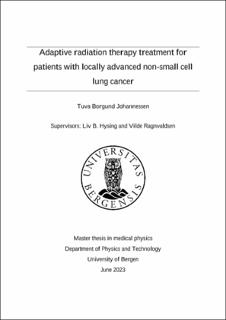Adaptive radiation therapy treatment for patients with locally advanced non-small cell lung cancer
Master thesis
Permanent lenke
https://hdl.handle.net/11250/3072110Utgivelsesdato
2023-06-01Metadata
Vis full innførselSamlinger
- Master theses [170]
Sammendrag
For locally advanced non-small cell lung cancer (LA-NSCLC) the current state-of-the-art treatment is intensity modulated radiation therapy (IMRT) using photons. Radiation therapy of LA-NSCLC can be challenging because of anatomical changes in the treatment region, and there is an increased risk of missing the treatment target and irradiating healthy tissue. Adaptive radiation therapy (ART) has the potential to improve the treatment by adjusting it for uncertainties like this. The purpose of this thesis was to investigate the dosimetric impact of anatomical changes over the course of the treatment, and studying how well the HUH traffic light protocol worked for identifying these changes. Forty-one LA-NSCLC patients primarily treated with photon IMRT (60 or 66 Gy by 2 Gy per fraction) were included in the study, and anatomical changes present had been registered following the traffic light protocol. Recalculating the original treatment plan onto CT scans made it possible to evaluate dosimetric variation between planning, and the first and third week of treatment, by studying target volume and organs at risk (OAR). Patients receiving tumor-match treatment as a result from the protocol, were studied further by recalculating based on tumor-match instead of bone-match alignment as initially conducted. Results: Target coverage was significantly better at planning compared to the first and third week of treatment, and 19/79 recalculations resulted in CTV V95% < 99%. Of these 19 recalculations, 17 were identified by the protocol with a degree of anatomical change. All replan adaptations made based on the protocol resulted in better target coverage but jeopardized healthy tissue. Tumor-match had no overall significant impact on the target coverage, and only 4/21 tumor-match treatments were beneficial based on our results. Conclusion: Patients who were at risk of low target coverage got detected by the HUH traffic light protocol, but proper protocol training was necessary. Impacts for OAR dosage was too complex to anticipate by the protocol, and this needs further research for patients prone to overdosage of OARs.
